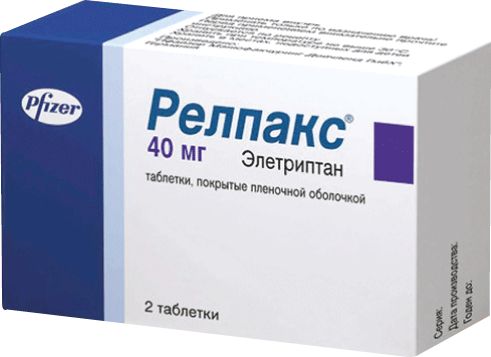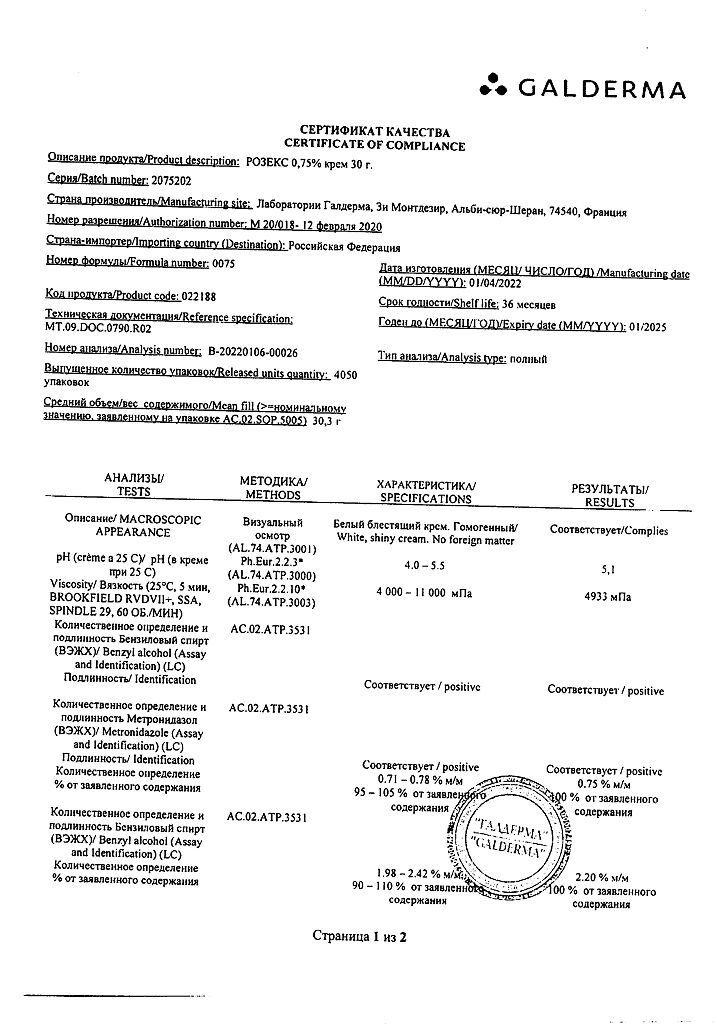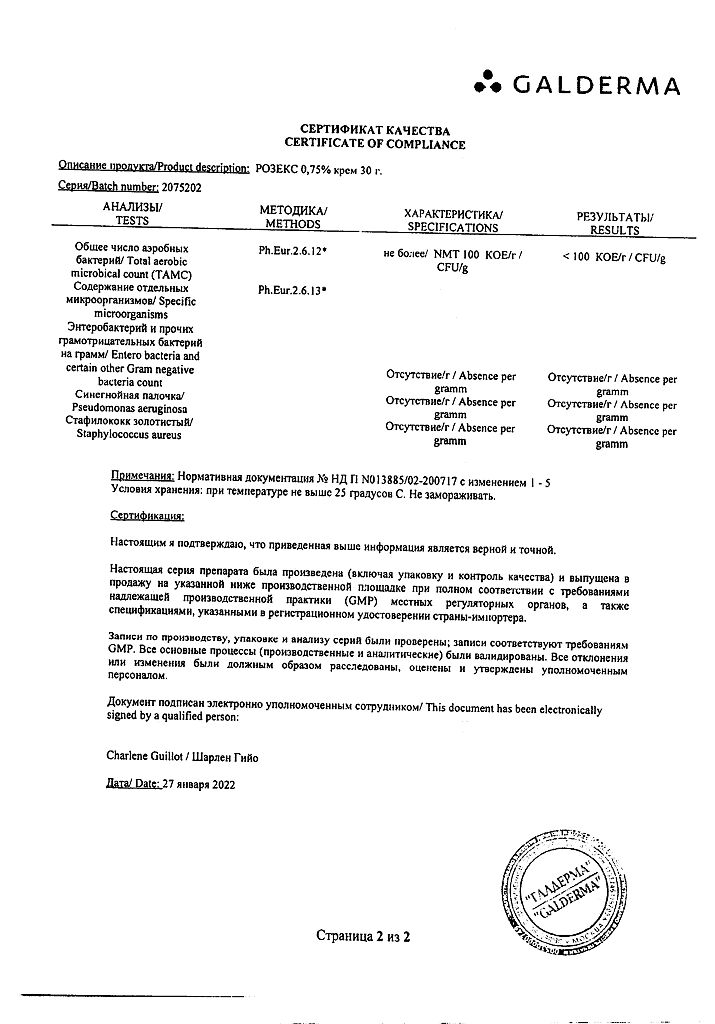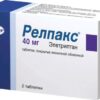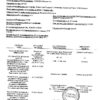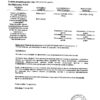No products in the cart.
Relpax, 40 mg 2 pcs
€21.07 €17.56
Description
Pharmacodynamics
The drug used for migraine.
Eletriptan is a representative of the group of selective agonists of serotonin 5-NT 1B – and 5-NT 1D – receptors, which are mainly located in the blood vessels of the brain. When these receptors are stimulated, vasoconstriction occurs, particularly in the carotid arteries, which leads to a reduction of headache.
. Eletriptan also has high affinity to serotonin 5-HT 1F – receptors, has moderate effect on serotonin 5-HT 1A -, 5-HT 2B -, 5-HT 1E – and 5-HT 7 – receptors, compared to sumatriptan, eletriptan shows greater selectivity for serotonin receptors located in carotid arteries than in coronary and femoral arteries. The ability of eletriptan to narrow intracranial blood vessels as well as its inhibitory effect against neurogenic inflammation may account for its antimigraine activity.
Pharmacokinetics
Intake
Eletriptan is rapidly and fairly completely absorbed from the GI tract after oral administration (absorption is about 81%). In men and women absolute bioavailability in oral administration is about 50%. The time to reach plasma C max was on average 1.5 h after oral administration. In the range of therapeutic doses (20-80 mg) the pharmacokinetics of eletriptan is characterized by a linear dependence.
The C max of eletriptan in plasma and the AUC were increased by approximately 20-30% when the drug was taken after consuming a fatty meal. When administered orally during a migraine attack, the AUC decreased by approximately 30%, and the time to reach plasma C max increased to 2.8 h.
Distribution
When administered regularly (20 mg 3 times/day) for 5-7 days, the pharmacokinetics of eletriptan remained linear with predictable cumulation. When administered at higher doses (40 mg 3 times/day and 80 mg 2 times/day) for 7 days, the cumulation of eletriptan was greater than expected (approximately 40%).
The V d of eletriptan on IV administration is 138 L, indicating good tissue distribution. Eletriptan binds moderately to proteins (approximately 85%).
Metabolism
In vitro studies indicate that the primary metabolism of eletriptan occurs under the action of CYP3A4 isoenzyme in the liver. This fact is confirmed by increased concentrations of eletriptan in plasma when concomitant use of erythromycin, which is a potent selective inhibitor of CYP3A4. In vitro studies also demonstrate a small involvement of CYP2D6 in the metabolism of eletriptan, although clinical studies have not shown any evidence of polymorphism of this enzyme.
Two major circulating metabolites have been identified, the proportion of which accounts for a significant proportion of the total plasma radioactivity after administration of 14C-labeled eletriptan . The metabolite formed by N-oxidation had no activity in in vitro animal experiments. The metabolite resulting from N-demethylation was comparable in activity to eletriptan in animal studies in vitro. A third component of the radioactive plasma has not been identified; it is believed to be a mixture of hydroxylated metabolites, which are also excreted in the urine and feces.
The plasma concentration of the active N-demethylated metabolite is only 10-20% of that of eletriptan and therefore does not contribute significantly to its therapeutic effect.
The total plasma clearance of eletriptan after IV administration is on average 36 l/h, and T 1/2 is approximately 4 h. Mean renal clearance after oral administration is approximately 3.9 l/h. The proportion of extra-renal clearance is approximately 90% of total clearance; this indicates that eletriptan is excreted primarily as metabolites in the urine and feces.
Pharmacokinetics in Special Clinical Cases
The results of a meta-analysis of clinical and pharmacological studies and a population pharmacokinetic analysis indicate that gender has no clinically significant effect on plasma concentrations of eletriptan.
The elderly (65-93 years) showed a small and statistically insignificant decrease (16%) in eletriptan clearance and a statistically significant increase in T 1/2 (from approximately 4.4 to 5.7 h) compared to those in young adults. Age had no effect on the incidence of side effects.
The pharmacokinetics of eletriptan (40 mg and 80 mg) in adolescents aged 12-17 years with migraine who took the drug between attacks were similar to those of healthy adults.
In children aged 7-11 years, the clearance of eletriptan was not different from that of adolescents, with lower V d . Plasma concentrations of the drug are higher than expected after administration of eletriptan at the same dose in adults.
In patients with impaired liver function (Child-Pugh grades A and B) there was a statistically significant increase in AUC (by 34%) and T 1/2 , and a small increase in C max (by 18%), but these small changes are not considered clinically significant.
In patients with mild (creatinine clearance (CK) 61-89 ml/min), moderate (CK 31-60 ml/min), and severe (CK < 30 ml/min) renal function impairment, no statistically significant changes in aletriptan pharmacokinetics or its binding to plasma proteins were found.
Indications
Indications
For rapid relief (control) of migraine attacks with and without aura.
Active ingredient
Active ingredient
Composition
Composition
Orange film-coated, round, biconvex tablets with “REP 40” engraved on one side and “Pfizer” on the other.
1 tablet eletriptan hydrobromide48.485 mg, which corresponds to the content of eletriptan40 mg
Associates:
Microcrystalline cellulose – 93.015 mg,
Lactose monohydrate – 46 mg,
croscarmellose sodium – 10 mg,
Magnesium stearate – 2.5 mg.
Composition of the film coating:
Opadray orange OY-LS-23016 (hypromellose, lactose monohydrate, titanium dioxide (E171), triacetin, sunset yellow dye with aluminum varnish (E110)) – 6 mg, opadray clear YS-2-19114-A (hypromellose, triacetin) – 1 mg.
How to take, the dosage
How to take, the dosage
The drug is prescribed orally. The tablets should be swallowed whole with water.
In case of migraine headache, Relpax should be taken as soon as possible after the onset of the migraine headache, but the drug is also effective at a later stage of the migraine attack.
For adult patients (ages 18-65 years), the recommended starting dose is 40 mg. If the migraine headache subsides but then recurs within 24 hours, Relpax may be reapplied at the same dose.
If a second dose is needed, it should be taken no sooner than 2 hours after the first dose.
If the first dose of Relpax does not relieve the headache within 2 hours, then a second dose should not be taken to relieve the same attack, as this has not been proven effective in clinical trials. However, patients who have failed to control an attack may have an effective clinical response in their next attack.
If the 40-mg dose does not produce an adequate effect, then the 80-mg dose may be effective for subsequent migraine attacks.
The daily dose should not exceed 160 mg.
Interaction
Interaction
In concomitant administration of erythromycin (1 g) and ketoconazole (400 mg), which are potent specific inhibitors of CYP3A4, a significant increase of C max (2 and 2.7 times respectively) and AUC (3.6 and 5.9 times respectively) of aletriptan was found. These effects were accompanied by an increase in T 1/2 of eletriptan from 4.6 to 7.1 h when using erythromycin and from 4.8 to 8.3 h when using ketoconazole. Therefore, Relpax should not be used in combination with potent CYP3A4 inhibitors, in particular with ketoconazole, itraconazole, erythromycin, clarithromycin, jozamycin and protease inhibitors (ritonavir, indinavir and nelfinavir).
The interaction of Relpax with beta-adrenoblockers, tricyclic antidepressants, selective serotonin reuptake inhibitors and flunarizine has not been identified, but there are currently no results of specific clinical studies on interactions with these drugs (except for propranololol).
Population pharmacokinetic analysis of clinical studies has shown that the effects of the following drugs on the pharmacokinetics of Relpax are unlikely: Beta-adrenoblockers, tricyclic antidepressants, selective serotonin reuptake inhibitors, estrogen-containing OST drugs and estrogen-containing oral contraceptives, and calcium channel blockers.
Eletriptan is not an MAO substrate. Therefore, no interaction of Relpax and MAO inhibitors is expected, and no specific studies of their interaction have been conducted.
Concomitant administration of propranololol (160 mg), verapamil (480 mg) or fluconazole (100 mg) increased C max of eletriptan by 1.1, 2.2 and 1.4 times, and its AUC – 1.3, 2.7 and 2 times respectively. These changes are considered clinically insignificant, because they were not accompanied by an increase in BP or an increase in the incidence of adverse events compared to that with eletriptan alone.
The oral administration of caffeine/ergotamine 1 and 2 h after Relpax results in a small but additive increase in BP that could have been predicted based on the pharmacological properties of these drugs. Therefore, drugs containing ergotamine or ergotamine derivatives (including dihydroergotamine ) should not be administered within 24 h after administration of Relpax.
In contrast, Relpax should not be administered earlier than 24 hours after taking ergotamine-containing medications.
The effect of eletriptan on other drugs
There is no evidence in vitro or in vivo that Relpax at clinical doses inhibits or induces cytochrome P 450 isoenzymes. A clinically significant interaction of Relpax due to effects on these enzymes seems unlikely.
Interaction with serotonergic drugs
The concomitant use of serotonin 5-NT receptor agonists, including eletriptan with drugs that have serotonergic activity, such as selective serotonin reuptake inhibitors and selective serotonin and noradrenaline reuptake inhibitors, may increase the risk of serotonin syndrome.
In case of clinical necessity, concomitant use of eletriptan and serotonergic drugs requires caution. Such patients should be closely monitored, especially at the beginning of treatment and when increasing the dose of each drug.
Special Instructions
Special Instructions
The use of Relpax in combination with potent CYP3A4 isoenzyme inhibitors, particularly ketoconazole, itraconazole, erythromycin, clarithromycin, jozamycin and protease inhibitors such as ritonavir, indinavir and nelfinavir, is not recommended. In addition, Relpax should not be taken within 72 h after completion of CYP3A4 isoenzyme inhibitors.
Like other serotonin 5-NT1 receptor agonists, Relpax should be used only when the diagnosis of migraine is beyond doubt.
Relpax, like other serotonin 5-HT1 receptor agonists, should not be prescribed to treat “atypical” headaches that may be associated with serious illness (stroke, ruptured aneurysm), where narrowing of cerebral vessels may be harmful.
In the background of using serotonin 5-NT1 receptor agonists, there have been cases of cerebral hemorrhage, subarachnoid hemorrhage, stroke or other cerebrovascular disorders, in some cases with a fatal outcome. In several cases, the cerebrovascular disorder was the underlying disease and serotonin 5-NT1 receptor agonists were used incorrectly, treating the symptoms as signs of migraine. Note that patients with migraine may be at increased risk of cerebrovascular complications (e.g., stroke, hemorrhage, and transient ischemic attack).
The concomitant use of eletriptan and SSRIs (e.g., fluoxetine, paroxetine, sertraline, fluvoxamine, citalopram, escitalopram) and SSRIs (e.g., venlafaxine, duloxetine) may result in potentially life-threatening serotonin syndrome. This syndrome may manifest as the following symptoms: impaired mental status (e.g., agitation, hallucinations, coma), autonomic nervous system instability (e.g., tachycardia, BP fluctuations, hyperthermia), neuromuscular system impairment (e.g., hyperreflexia, coordination disorders) and/or digestive system symptoms (e.g., nausea, vomiting, diarrhea).
Relpax is not recommended in patients with risk factors for CHD (e.g., arterial hypertension, hypercholesterolemia, smoking, obesity, diabetes, a poor family history, women in surgical or physiological menopause or men over age 40) until a thorough circulatory system evaluation has been performed and cardiovascular disease has been excluded.
The sensitivity of cardiovascular assessment methods is quite low. Therefore, if the patient has a history of arterial vasospasm or myocardial ischemia on ECG or other diagnostic procedures, Eletriptan is not recommended.
In patients with cardiovascular risk factors, but in whom cardiovascular assessment has shown satisfactory results, it is recommended that the first dose of eletriptan be taken under medical supervision, except in patients who have previously received eletriptan. Because myocardial ischemia may occur in the absence of clinical symptoms, consideration should be given to performing an ECG immediately after administration of Relpax.
Patients with cardiovascular risk factors, as described above, who receive eletriptan long-term but intermittently, should have periodic cardiovascular assessments as they continue therapy with eletriptan.
Systematic adherence to the above recommendations results in fewer cases of patients with unspecified cardiovascular disease receiving eletriptan therapy.
In the use of serotonin 5-NT1 receptor agonists, cases of severe cardiac dysfunction, including myocardial infarction, life-threatening cardiac arrhythmias, and death have been reported that developed in the first few hours after taking the drug. Taking into account the wide use of serotonin 5-NT1 receptors in patients with migraine, the frequency of these reactions is extremely low.
The following reports were received during clinical trials. Among patients undergoing diagnostic coronary angiography, one patient receiving eletriptan IV (Cmax 127 ng/mL, equivalent to 60 mg of oral eletriptan) with a history of angina pectoris, arterial hypertension and hypercholesterolemia experienced chest tightness and coronary angiospasm (confirmed by angiography) without ECG changes characteristic of ischemia. In addition, one case of atrial fibrillation has been reported in a patient with such a history of rhythm disturbance.
In the post-marketing period, cases of severe cardiovascular complications, some of them fatal, have been reported. In very rare cases, these complications have occurred in the absence of any evidence of cardiovascular disease. However, given the difficulty of monitoring post-marketing reports, it is not possible to definitively determine the relationship of these cases to the administration of eletriptan.
Relpax should not be prescribed without prior evaluation in patients who are likely to have cardiovascular disease or are at increased risk of developing it. There has been no systemic study of eletriptan in patients with heart failure. The use of eletriptan, as well as other serotonin 5-NT1 receptor agonists, is not recommended in these patients.
Relpax is effective in the treatment of migraine with and without aura and migraine accompanying the menstrual cycle. Relpax taken during the onset of aura does not prevent headaches, so it should only be taken during the headache phase.
In clinical studies, Relpax has also been found to be effective in relieving symptoms that accompany migraine, such as nausea, vomiting, photophobia, phonophobia, and in treating a return headache during an attack.
Relpax should not be taken prophylactically.
When using Relpax at therapeutic doses of 60 mg or more, small and transient increases in BP have been reported.
The BP elevation was greater in patients with impaired renal function and in the elderly.
It should be kept in mind that unrestricted use of antimigraine medications may lead to chronic daily headaches. Cases of overuse of any triptans are most commonly seen in patients with daily headaches.
Effects on driving and operating machinery
In some cases, migraine itself or administration of serotonin 5-HT1 receptor agonists, including Relpax, may be accompanied by drowsiness or dizziness. Patients should exercise caution during migraine episodes and after taking Relpax in activities that require increased attention, such as driving and operating complex machinery.
Contraindications
Contraindications
Side effects
Side effects
In general, Relpacs is well tolerated. Usually side effects are transient, mild to moderate in severity, and go away on their own without additional treatment. The frequency of adverse reactions in patients taking the drug 2 times within 24 hours in the same dose to control an attack is similar to that in patients taking the drug once. The main side effects reported during treatment with Relpax are typical for the entire class of serotonin 5-NT1 receptor agonists.
The use of serotonin 5-NT1 receptor agonists, including Relpax, has reported cases of serious cardiovascular adverse events, in some cases with a fatal outcome. These reactions have been extremely rare and have occurred primarily in patients with comorbid risk factors.
Respiratory system: often – pharyngitis, rhinitis, feeling of “tightness” in the throat; sometimes – dyspnea, yawning; rarely – respiratory tract infections, bronchial asthma, voice tone changes.
Lymphatic system disorders: rarely – lymphadenopathy.
Metabolism: infrequent – anorexia.
Mental disorders: infrequent thought disorder, agitation, confusion, depersonalization, euphoria, depression, insomnia; rarely – emotional lability.
Nervous system disorders: frequently – somnolence, headache, dizziness, “tingling” sensation or other sensitivity disorders, muscle hypertonicity, hypoesthesia, myasthenia; infrequently – tremor, hyperesthesia, ataxia, hypokinesia, speech disorders, stupor state, violation of sense of taste.
Sensory organs: frequently – vertigo; infrequent – visual impairment, eye pain, photophobia and impaired lacrimation, ear pain, tinnitus; rarely – conjunctivitis.
The cardiovascular system: often – palpitations, tachycardia; rarely – angina pectoris, increased BP, bradycardia, shock.
The digestive system: frequently – abdominal pain, nausea, dry mouth, dyspepsia; infrequently – diarrhea, glossitis; rarely – constipation, esophagitis, tongue swelling, belching, hyperbilirubinemia, increased ACT activity.
Skin and subcutaneous tissue: frequently – increased sweating; infrequently – rash, itching, rarely – skin diseases, urticaria.
Muscular system: often – back pain, muscle pain; infrequent – joint pain, osteoarthritis and bone pain; rarely – arthritis, myopathy, myalgia, seizures.
Urinary system disorders: infrequent – frequent urination, polyuria.
Reproductive system disorders: rarely – pain in the mammary glands, menorrhagia.
General disorders: frequently – sensation of warmth or “flushes” of heat to the face, chills, asthenia, symptoms from the chest (pain, feeling of compression, pressure); infrequently – general weakness, swollen face, thirst, peripheral edema.
Side effects reported in post-marketing studies
Nervous system disorders: rarely – fainting.
Cardiovascular system: arterial hypertension.
Digestive system disorders: rare – ischemic colitis, vomiting.
Allergic reactions: angioedema.
Overdose
Overdose
Symptoms: possible development of arterial hypertension or other disorders of the cardiovascular system.
Treatment: gastric lavage, symptomatic therapy. T1/2 of eletriptan is about 4 hours, therefore in case of overdose patients should be monitored for at least 20 hours or until clinical symptoms of overdose disappear. The effect of hemodialysis and peritoneal dialysis on plasma concentrations of eletriptan is unknown.
Pregnancy use
Pregnancy use
There is no clinical experience with the use of Relpacs in pregnancy. The use of the drug is possible only in cases when the estimated benefit of therapy for the mother exceeds the potential risk to the fetus.
Eletriptan is excreted with breast milk in women. When a single administration of the drug Relpax in a dose of 80 mg, excretion with breast milk within 24 hours was on average 0.02% of the dose taken. The risk of exposure of the infant to eletriptan can be minimized by not breastfeeding for 24 hours after administration of Relpax.
In experimental animal studies, Relpax had no teratogenic effects.
Preventive use in children
Contraindication: children and adolescents under 18 years of age (data on the efficacy and safety of the drug in this age group is limited).
Pediatric use
Contraindication: children and adolescents under 18 years of age (data on the efficacy and safety of the drug in this age group is limited).
Additional information
| Weight | 0.015 kg |
|---|---|
| Shelf life | 3 years. |
| Conditions of storage | Store at temperatures not exceeding 30 ° C, out of the reach of children. |
| Manufacturer | Pfizer Italy S.r.l., Italy |
| Medication form | pills |
| Brand | Pfizer Italy S.r.l. |
Related products
Buy Relpax, 40 mg 2 pcs with delivery to USA, UK, Europe and over 120 other countries.

